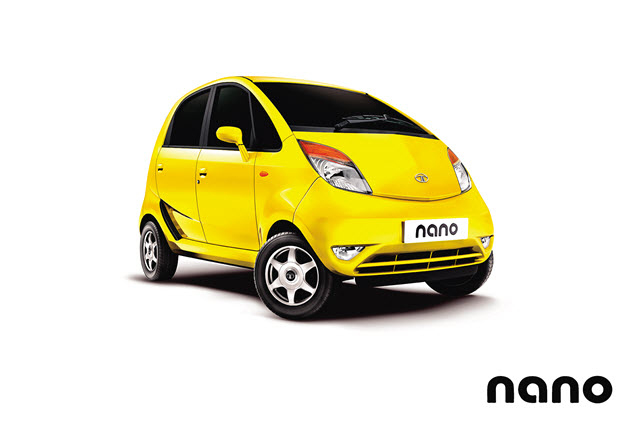BRICs: India Innovates
Tata's Nano Ambitions

Source:Tata
The ultra-affordable Nano means ordinary Indian families need no longer brave the rains squeezed together on a motorbike, and it may help Tata Motors ride the energy-conservation wave into Europe and North America.
Views
Tata's Nano Ambitions
By Hsiao-Wen WangFrom CommonWealth Magazine (vol. 428 )
Indians have a saying: In India you run into Tata every five minutes.
Seated like a princess at the gates of the Arabian Sea, basking in the warm, salty breeze, is the Taj Mahal Palace & Tower, the finest hotel in Mumbai. The Tetley tea you sip in any restaurant, the billboard for Tata Indiacom over on the street corner – everywhere you look, something made by the Tata Group is lying in wait.
An Indian business goliath with annual revenues of nearly NT$2.4 trillion, Tata has become a hot topic in business circles recently after unveiling its new Nano subcompact, the world's cheapest automobile. With a price tag of 100,000 rupees (about US$2,500 or NT$80,000 at the time of the car's release), the Nano is set to hit the streets before the end of the year.
When Mr. Ratan Tata said he wanted to produce a car that sold for just 100,000 rupees, everyone shook their heads and said it was not possible, Prakash M. Telang, current managing director of India operations and soon-to-be CEO of Tata Motors Ltd., tells CommonWealth Magazine.
But once the target was set, the company's white collar managers, blue collar workers and engineers set about breaking down the boundaries and figuring out ways to lower costs, Telang relates as he fiddles with his tie, explaining apologetically to his guests that he feels more comfortable in his factory uniform.
With a watercolor portrait of second-generation scion J.R.D. Tata adorning the wall of his otherwise Spartan office, Telang seems to have spent years working under the silent gaze of the Tata family. Aside from the portrait of the Tata family boss on the wall, the only other adornment is a small statuette of the elephant-headed Hindu deity Ganesh.
Once Ratan Tata laid out his vision for the Nano, Tata Motors, India's automotive leader, embarked on a five-year, US$400 million developmental odyssey.
Simple to Simplest, Minimal to Minimalist
The biggest challenge was figuring out how to minimize the use of materials and reduce the size of the auto body without sacrificing overall quality.
Tata started with the engine, the biggest single cost-element in an automobile. The Nano incorporates a two-cylinder engine instead of a four, rear-mounted like a Volkswagen Beetle, that propels the tiny car from 0-100 kph in 23 seconds.
To reduce weight, Tata had to rethink every component, from the 12-inch wheels to the single windshield wiper to the thin yet rigid sheet metal and even the upholstery covering the seats. This extreme devotion to weight consciousness means the Nano tips the scales at under half the weight of a Honda Accord.
In a country where annual automobile sales are just 1.4 million units and motorbike sales seven million units, it would appear from the 200,000 Nanos moved during the six-week pre-sales period that Tata has definitely tapped into a latent market potential.
The passionate reception Nano has received may well force international automakers to reconsider the value of expensive options that consumers don't really need, automotive magazine AutoCar India conjectured.
The Subcompact Chase Is On
Yet Nano is already facing competition. India's Bajaj and Renault-Nissan have both announced that they will introduce inexpensive subcompacts in the Nano's price range for the 2011 model year.
The whole of the automotive world is watching the Nano's potential. According to research by accounting firm PriceWaterhouseCoopers, the four BRIC nations – Brazil, Russia, India and China – will account for half of the growth in the global automotive industry in the years 2006-2011.
In India alone, rapidly growing demand stands as one of Tata's most daunting challenges. To achieve their target of one million Nano sales annually, acceleration of production capacity has become a top priority. Tata's current production facility in northern India has a capacity of just 50,000 units per year, and its new plant with a capacity of 500,000 units annually won't be ready for production until the year's end at the earliest.
And the markets of Europe and North America, which initially did not figure into Tata's business plans, are suddenly on the company's radar. Should the opportunity arise, Tata is already in full compliance with European emissions standards, Telang relates.
With soaring fuel prices and spurred on by rising environmental consciousness, the Nano, originally developed for the African, Latin American and Southeast Asian markets, has begun to attract interest in Europe and North America. Call it serendipity.
On a Mumbai street Tata cars are on display alongside Jaguars and Land Rovers, luxury marques that Tata purchased from Ford last year at a cost of US$2.3 billion. But the intoxicatingly stylish exhibition does nothing to erode Telang's reason. He knows India has a long way to go in catching up to the world's automotive giants.
Yet it may be no coincidence that India was the birthplace of the world's most inexpensive car.
Such innovation would perhaps make Sir Frederick Upcott rue his words of a century earlier. The former British chief commissioner of Indian railways, Upcott once illustrated his disdain for Indian industrial capacity by pledging, "I will undertake to eat every pound of steel rail they succeed in making."
Eating one's words indeed.
Translated from the Chinese by Brian Kennedy
Profile: Tata Motors Ltd.
Founded: 1945
Operating Revenue: 709.4 billion rupees (about NT$479.4 billion) (March 2008 – March 2009)
After-tax Earnings: Loss of 25 billion rupees (about NT$16.9 billion)
Workforce: 23,000
Chinese Version: 八萬元小車 六週賣出二十萬台






